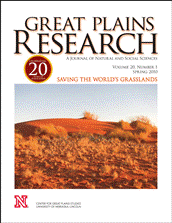Center for Great Plains Studies

Great Plains Research: A Journal of Natural and Social Sciences (through 2013)
Date of this Version
Spring 2005
Document Type
Article
Abstract
Behavioral segregation between the sexes of bison (Bas bison), coupled with artificially manipulated sex ratios of bison herds, might profoundly influence prairie ecosystems. Therefore, we measured carbon isotopes in hair collected from bison from the Tallgrass Prairie Preserve in northeast Oklahoma to determine if adult male, adult female, and juvenile bison segregate on the basis of botanical composition of their diet. Sex ratio of bison herds in the Great Plains and behavioral differences between sexes were used to assess potential effects of sex ratio on tallgrass prairie. Botanical composition of diet differed among the three bison groups, in that C4 grasses contributed most to adult bull diets and least to juvenile diets. Bison sex ratio in half of the herds surveyed was highly skewed toward females. Because of behavioral differences between adult male and female bison, different sex ratios in bison herds might result in different vegetation structure, composition, and patchiness.


Comments
Published in Great Plains Research Vol. 15, No. 1, 2005. Copyright © 2005 The Center for Great Plains Studies, University of Nebraska–Lincoln. Used by permission.